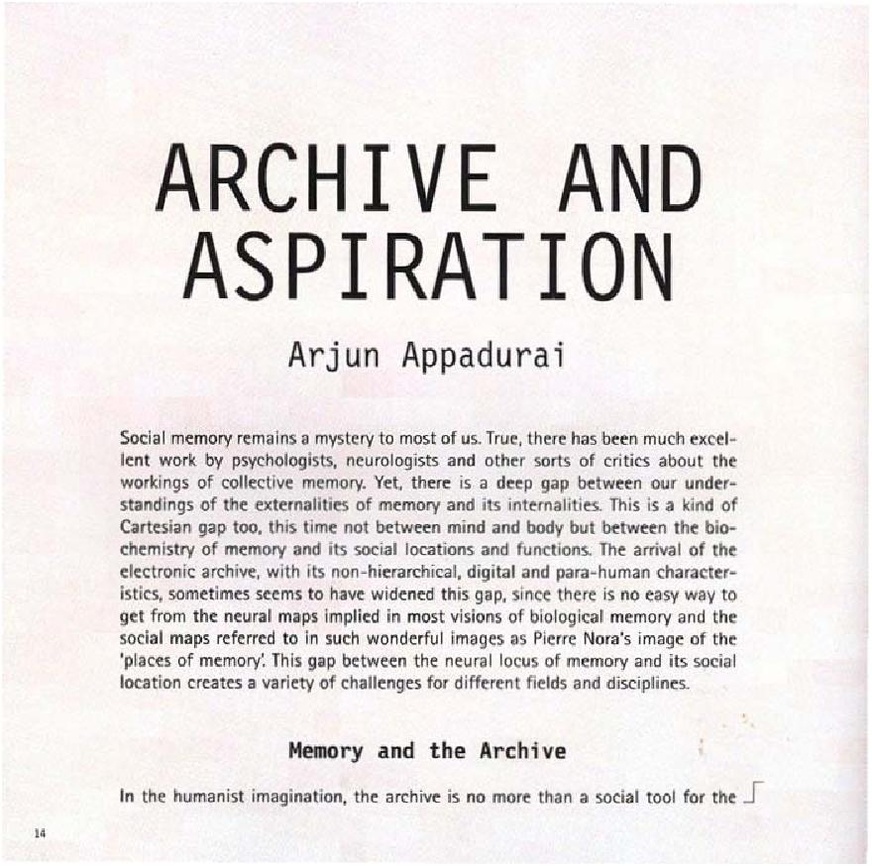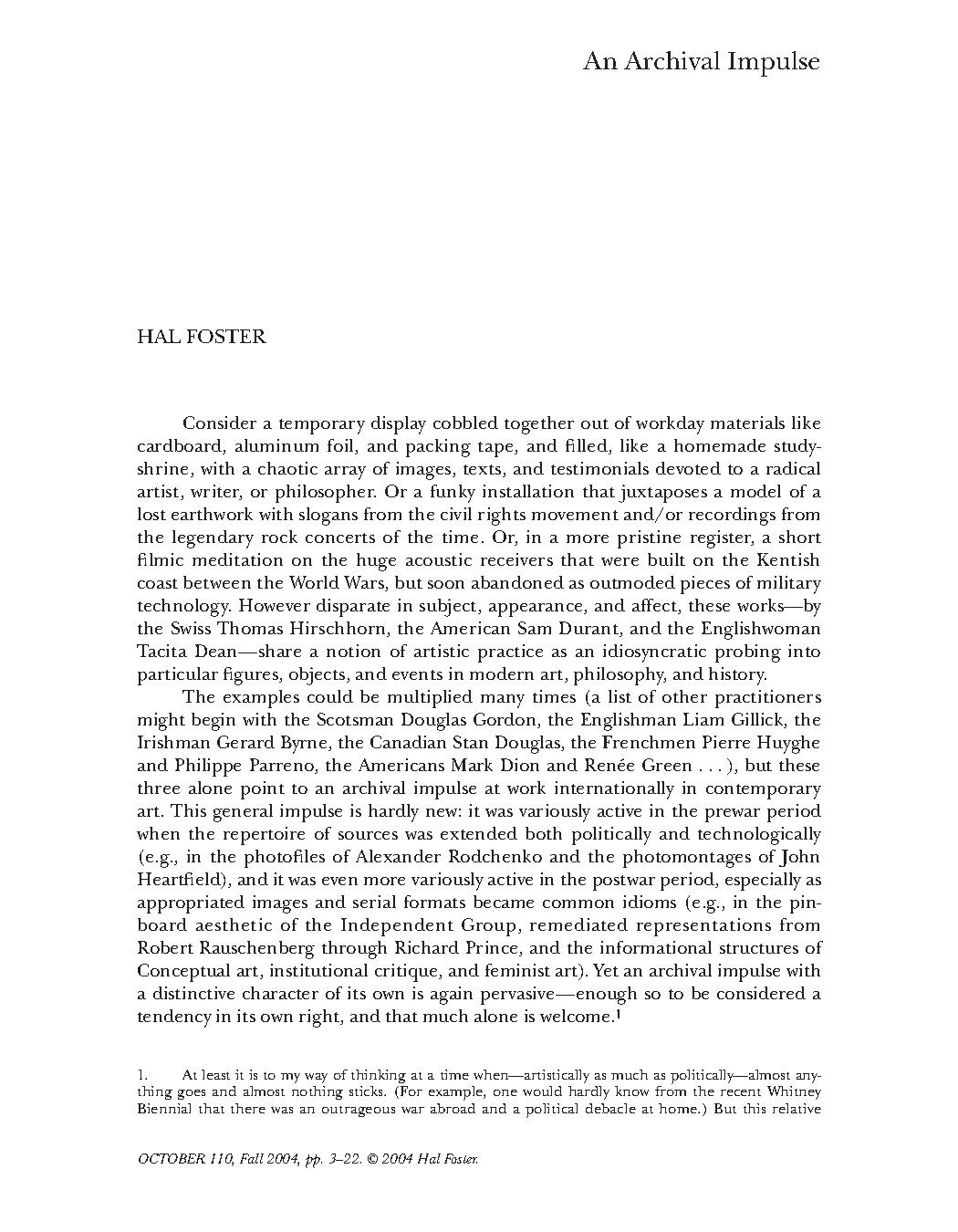Testing the shelf life: Difference between revisions
| Line 32: | Line 32: | ||
'''Programme planning''' | '''Programme planning''' | ||
==Tuesday 24 September== | |||
Introduction | Introduction | ||
==Thursday 3 October== | |||
Documentation & Presentation | Documentation & Presentation | ||
| Line 51: | Line 51: | ||
==Thursday 10 October== | |||
Archives & Found Footage | Archives & Found Footage | ||
| Line 57: | Line 57: | ||
Jacques Derrida (1995) Archive Fever. A Freudian Impression. '''READ ONLY pp. 9-21'''. | Jacques Derrida (1995) Archive Fever. A Freudian Impression. '''READ ONLY pp. 9-21'''. | ||
[[File:Derrida archive fever 1995.pdf| | [[File:Derrida archive fever 1995.pdf|none|Derrida_ArchiveFever]] | ||
Okwui Enwezor, Archive Fever: Photography between History and the Monument | Okwui Enwezor, Archive Fever: Photography between History and the Monument | ||
| Line 70: | Line 70: | ||
==Thursday 17== | |||
Invisible and inaudible voices | Invisible and inaudible voices | ||
| Line 76: | Line 76: | ||
Arjun Appadurai, Archive and Aspiration. In Information is Alive, edited by Joke Brouwer and Arjen Mulder 14-25. Rotterdam: V2_Publishing/NAI Publishers, pp.14-25 (2003) | Arjun Appadurai, Archive and Aspiration. In Information is Alive, edited by Joke Brouwer and Arjen Mulder 14-25. Rotterdam: V2_Publishing/NAI Publishers, pp.14-25 (2003) | ||
[[File:ArjunAppadurai ArchiveandAspiration.pdf|none]] | |||
Hal Foster (2004), An Archival Impulse. OCTOBER 110, Fall, pp. 3–22. | Hal Foster (2004), An Archival Impulse. OCTOBER 110, Fall, pp. 3–22. | ||
[[File:Hal foster the archival impulse.pdf|none]] | |||
Hito Steyerl (2008) Politics of the archive: Translations in film. http://eipcp.net/transversal/0608/steyerl/en | Hito Steyerl (2008) Politics of the archive: Translations in film. http://eipcp.net/transversal/0608/steyerl/en | ||
| Line 89: | Line 91: | ||
==Monday 28== | |||
Performativity & Process | Performativity & Process | ||
| Line 106: | Line 108: | ||
==Thursday 31== | |||
visit to Impakt festival | visit to Impakt festival | ||
==Thursday 7 November== | |||
''READERS:'' | ''READERS:'' | ||
| Line 119: | Line 121: | ||
==Tuesday 12== | |||
visit to MU – F.A.T. lab | visit to MU – F.A.T. lab | ||
==Thursday 21== | |||
visit film screenings WORM | visit film screenings WORM | ||
| Line 129: | Line 131: | ||
==Thursday 28== | |||
Authenticity / original: remix, authorship | Authenticity / original: remix, authorship | ||
| Line 147: | Line 149: | ||
==Thursday 5 December== | |||
final presentations / assessment | final presentations / assessment | ||
==Thursday 11 December== | |||
visit film screenings WORM | visit film screenings WORM | ||
Revision as of 12:20, 4 October 2013
Thematic Project Description
testing the documentation page
Testing the shelf life, on presentation, documentation and archives (or vice versa).
‘Igor !!!!!!! Can't you do something else to go through your mid-life crisis ???? !!!!!’ This exclamation was one of the responses to net artist Igor Stromajer’s post on Facebook that he was deleting his collection of online net art works. Expunction, the name of the project, was where one could follow the process of all the deletions, byte by byte. All that remains are the debates that took place on various platforms and documentation of Stromajer’s net art works from 1996 to 2007. In the debate Stromajer hinted at several reasons for his (drastic) measure ‘… to be honest, most of the projects I’m talking about, are nowadays appearing totally different in browsers, as they were in originals. Some of them you can’t even see/experience anymore. I was doing updates all these years, reprogramming, updating etc. But now it makes no sense anymore. (..) they are disappearing/dying anyway. So, it’s better if I ritually delete (and document) them. Because it makes no sense for the audience to watch/browse “damaged” works, to watch/browse something I didn’t actually do’.
The question of documentation and archiving is particular pertinent in today’s digital world, both from an artistic and a societal perspective. Some already predict a Digital Dark Age when nothing is done to safeguard digital data. What this remark shows foremost is an anxiety and urgency upon noticing that digital material has a short expiration date. That digital data is different from previous material is obvious to many people, but the practice shows that this does not automatically mean that a new approach is developed thinking from the new material In this thematic project attention will be paid to the importance of documentation and archiving: to their structure, organisation and power.
French philosopher Jacques Derrida made the claim that ‘the mutation in technology changes not simply the archiving process, but what is archivable – that is, the content of what has to be archived is changed by the technology’. What he means is that not only the style of the content is different through new processes and production, moreover the relation to time and space, being reduced to mere seconds one can reach someone in every corner of the world, has effected the content. The knowledge that information reaches someone within a certain time frame, which could immediately influence a situation, has of course an effect on power relations, in decision-making and accountability. It is generally known and accepted that archives construct a specific account of history, many things end up in an archive, but even more remain outside, to be forgotten. Questions like who is in charge of an archive, who selects, and for whom is the archive, have been plaguing archives from the beginning. One could argue that the digital accelerates this process and at the same time is making these processes more transparent. Some even claim that the Internet has become the archive of archives.
Digitisation has led museums, organisations, libraries and national archives to open their archives to the public, using the Internet as their interface. At times information is made more accessible in a way that people can add their own information, tag existing documents, or make relations between different documents. At the same time, the Internet audience is making their own archives uploading and posting their documents to peer-to-peer networks and/or large (commercial) databases. Derrida rightly assumed that technology has changed power relations; moreover, with the open structure of the Internet everyone has now the ability to be heard and influence existing content by adding their own. Such initiatives show multi-layered and multifaceted meanings of archiving. More than anything they exemplify that an archive is not simply a recording, a reflection, or an image of an event, but it shapes the event. Nevertheless old questions remain important, for example in what way the organisational structures influence the building and maintenance of archives: How are decisions made, where is the archive kept, who is making them, and with what aims?
Guided by many examples – theoretical texts, lectures, hands-on experience, artworks, screenings, visitors and visits – the performativity of documents, the art of documentation, and the presentation of processes will be discussed. While challenging and expanding existing notions, jumps will be made from the present to the past to the future, and back again. Throughout the course students will work on keeping track of their own documentation process.
Tutor
Annet Dekker is an independent researcher and curator. She is interested in the influence of technology, science and popular culture on art and vice versa. Currently she is a core visiting tutor at Piet Zwart Institute, Rotterdam and editor of an international publication for Baltan Laboratories, Speculative scenarios, or what will happen to digital art in the (near) future. In 2009 she initiated aaaan.net with Annette Wolfsberger; they coordinate artists-in-residences and set up strategic and sustainable collaborations with national and international arts organisations. Previously she worked as web curator for SKOR (Foundation for Art and Public Domain, 2010–12), was programme manager at Virtueel Platform (2008–10), and head of exhibitions, education and artists-in-residence at the Netherlands Media Art Institute (1999–2008). In 2008 she began a Ph.D. research into strategies for documenting net art at the Centre for Cultural Studies, Goldsmiths University, London, under the supervision of Matthew Fuller. http://aaaan.net
Schedule
Unless otherwise specified, Seminars will take place on Thursdays.
Preliminary schedule: changes are likely to take place, so keep an idea out to this page and the calender !
Programme planning
Tuesday 24 September
Introduction
Thursday 3 October
Documentation & Presentation
texts:
Walter Benjamin (1923) ‘The task of the translator’ http://www.scribd.com/doc/12733233/Walter-Benjamin-the-Task-of-Translator
Becky Edmunds (2004) 'A Work of Art from A Work of Art' http://beckyedmunds.com/#/on-documentation/4531976852
READERS:
Thursday 10 October
Archives & Found Footage
texts:
Jacques Derrida (1995) Archive Fever. A Freudian Impression. READ ONLY pp. 9-21.
Okwui Enwezor, Archive Fever: Photography between History and the Monument http://wiki.daviddarts.com/images/5/59/Archive_Fever.pdf
READERS:
Lucia Dossin
Lídia Pereira
Thursday 17
Invisible and inaudible voices
texts:
Arjun Appadurai, Archive and Aspiration. In Information is Alive, edited by Joke Brouwer and Arjen Mulder 14-25. Rotterdam: V2_Publishing/NAI Publishers, pp.14-25 (2003)
Hal Foster (2004), An Archival Impulse. OCTOBER 110, Fall, pp. 3–22.
Hito Steyerl (2008) Politics of the archive: Translations in film. http://eipcp.net/transversal/0608/steyerl/en
READERS:
visit Peter Fengler, The Player: Lawrence Abu Hamdan
Monday 28
Performativity & Process
texts:
Lee, Benjamin and Edward LiPuma (2002) Cultures of Circulation: The Imaginations of Modernity. Public Culture. Vol.14, No.1, pp. 191-213.
READERS:
visit Peter Fengler, The Player: Jacoba Bruneel
Thursday 31
visit to Impakt festival
Thursday 7 November
READERS:
afternoon visit to Netherlands Photomuseum with Frits Gierstberg: http://www.nederlandsfotomuseum.nl/en/visit-info/get-there
Tuesday 12
visit to MU – F.A.T. lab
Thursday 21
visit film screenings WORM
READERS:
Thursday 28
Authenticity / original: remix, authorship
texts:
Bruno Latour & Adam Lowe (2010) The migration of the aura or how to explore the original through its fac similes. In Switching Codes, edited by Thomas Bartscherer. Chicago: University of Chicago Press.
Olga Goriunova (2011) Organizational Aesthetics, Digital Folklore and Software. In: Art Platforms and Cultural Production on the Internet. London: Routledge.
Hito Steyerl (2009) In Defense of the Poor Image. http://www.e-flux.com/journal/in-defense-of-the-poor-image/
READERS:
guest visit from Robert Sakrowski & Igor Stromajer & Olia Lialina : special evening event at V2_ !
Thursday 5 December
final presentations / assessment
Thursday 11 December
visit film screenings WORM



